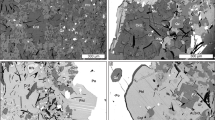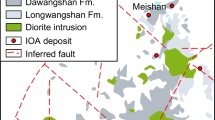Abstract
Calcite grew continuously for 500,000 years on the submerged walls of an open fault plane (Devils Hole) in southern Nevada, U.S.A. at rates of 0.3 to 1.3 mm/ka, but ceased growing approximately 60,000 years ago, even though the fault plane remained open and was continuously submerged. The maximum initial in-situ growth rate on pre-weighed crystals of Iceland spar placed in Devils Hole (calcite saturation index, SI, is 0.16 to 0.21 at 33.7 °C) for growth periods of 0.75 to 4.5 years was 0.22 mm/ka. Calcite growth on seed crystals slowed or ceased following initial contact with Devils Hole groundwater. Growth rates measured in synthetic Ca-HCO3 solutions at 34 °C, CO2 partial pressures of 0.101, 0.0156 (similar to Devils Hole groundwater) and 0.00102 atm, and SI values of 0.2 to 1.9 were nearly independent of PCO 2, decreased with decreasing saturation state, and extrapolated through the historical Devils Hole rate. The results show that calcite growth rate is highly sensitive to saturation state near equilibrium. A calcite crystal retrieved from Devils Hole, and used without further treatment of its surface, grew in synthetic Devils Hole groundwater when the saturation index was raised nearly 10-fold that of Devils Hole water, but the rate was only 1/4 that of fresh laboratory crystals that had not contacted Devils Hole water. Apparently, inhibiting processes that halted calcite growth in Devils Hole 60,000 years ago continue today.
Similar content being viewed by others
References
Arakaki, T. and Mucci, A. (1995) A continuous and mechanistic representation of calcite reactioncontrolled kinetics in dilute solutions at 25 °C and 1 atm total pressure. Aquatic Geochem. 1, 105–130.
Busenberg, E. and Plummer, L. N. (1986) A comparative study of the dissolution and crystal growth kinetics of calcite and aragonite. In: F. A. Mumpton (ed.), Studies in Diagenesis. U.S.Geol.Survey Bull. 1578, 139–168.
Chou, L., Garrels, R. M., and Wollast, R. (1989) Comparative study of the kinetics and mechanisms of dissolution of carbonate minerals. Chem.Geol. 78, 269–282.
Compton, R. G. and Brown, C. A. (1995) The inhibition of calcite dissolution/precipitation: 1,2-dicarboxylic acids. J.Colloid Interface Sci. 170, 586–590.
Coplen, T. B., Winograd, I. J., Landwehr, J. M., and Riggs, A. C. (1994) 500,000-year stable carbon isotopic record from Devils Hole, Nevada. Science 263, 361–365.
Dove, P. M. and Hochella, M. F., Jr. (1993) Calcite precipitation mechanisms and inhibition by orthophosphate: In situ observations by scanning force microscopy. Geochim.Cosmochim.Acta 57, 705–714.
Dreybrodt, W., Buhmann, D., Michaelis, J., and Usdowski, E. (1992) Geochemically controlled calcite precipitation by CO2 outgassing: Field measurements of precipitation rates in comparison to theoretical predictions. Chem.Geol. 97, 285–294.
Dreybrodt, W., Eisenlohr, L., Madry, B., and Ringer S. (1997) Precipitation kinetics of calcite in the system CaCO3-H2O-CO2: The conversion of CO2 by the slow process H+ + HCO -3 → CO2 + H2O as a rate limiting step. Geochim.Cosmochim.Acta 61, 3897–3904.
Eakin, T. E. (1966) A regional interbasin groundwater system in the White River area, southeastern Nevada. Water Resour.Res. 2, 251–271.
Ford, D. C., Lundberg, J., Palmer, A. N., Palmer, M. V., Dreybrodt, W., and Schwarcz, H. P. (1993) Uranium-series dating of the draining of an aquifer: The example of Wind Cave, Black Hills, South Dakota. Geol.Soc.Amer.Bull. 105, 241–250.
Herman, J. S. and Lorah M. M. (1988) Calcite precipitation rates in the field: Measurement and prediction for a travertine-depositing stream. Geochim.Cosmochim.Acta 52, 2347–2355.
Inskeep, W. P. and Bloom, P. R. (1985) An evaluation of rate equations for calcite precipitation kinetics at PCO2 less than 0.01 atm and pH greater than 8. Geochim.Cosmochim.Acta 49, 2165–2180.
Inskeep, W. P. and Bloom P. R. (1986) Kinetics of calcite precipitation in the presence of watersoluble organic ligands. Soil Sci.Soc.Am.J. 50, 1167–1172.
Katz, J. L., Reick, M. R., Herzog, R. E., and Parsiegla, K. I. (1993) Calcite growth inhibition by iron. Langmuir 9, 1423–1430.
Kavanagh, A. M., Rayment, T., and Price, T. J. (1990) Inhibitor effects on calcite growth at low supersaturations. J.Chem.Soc.Faraday Trans. 86, 965–972.
Liu, Z. and Dreybrodt, W. (1997) Dissolution kinetics of calcium carbonate minerals in H2O-CO2 solutions in turbulent flow: The role of the diffusion boundary layer and the slow reaction H2O + CO2 = H+ + HCO -3 . Geochim.Cosmochim.Acta 61, 2879–2889.
Liu, Z., Svensson, U., Dreybrodt, W., Daoxian, Y., and Buhmann, D. (1995) Hydrodynamic control of inorganic calcite precipitation in Huanglong Ravine, China: Field measurements and theoretical prediction of deposition rates. Geochim.Cosmochim.Acta 59, 3087–3097.
Ludwig, K. R., Simmons, K. R., Szabo, B. J., Winograd, I. J., Landwehr, J. M., Riggs, A. C., and Hoffman, R. J. (1992) Mass-Spectrometric 230Th-234U-238U dating of the Devils Hole calcite vein. Science 258, 284–287.
Meyer, H. J. (1984) The influence of impurities on the growth rate of calcite. J.Crystal Growth 66, 639–646.
Mifflin, M. D. (1968) Delineation of ground-water flow systems in Nevada. Tech.Rept Ser.H-W, Hydrol.and Water Resour. Pub. No. 4, Center for Water Resources Research, Desert Research Institute, University of Nevada System, Reno, Nevada, 89 pp.
Morse, J. W. (1983) The kinetics of calcium carbonate dissolution and precipitation. In: R. J. Reeder (ed.), Reviews in Mineralogy Vol. 11. Mineralogical Society of America, Washington DC, pp. 227–264.
Nancollas, G. H. and Reddy, M. M. (1971) The crystallization of calcium carbonate. II. Calcite growth mechanism. J.Colloid Interface Sci. 37, 824–830.
Plummer, L. N., Wigley, T. M. L., and Parkhurst, D. L. (1978) The kinetics of calcite dissolution in CO2-water systems at 5 to 60 °C and 0.0 to 1.0 atm CO2. Amer.J.Sci. 278, 179–216.
Plummer, L. N., Parkhurst, D. L., and Wigley, T. M. L. (1979) Critical review of the kinetics of calcite dissolution and precipitation. In: E. A. Jenne (ed.), Chemical Modeling in Aqueous Systems. Amer.Chem.Soc.Symp.Series 93, 537–573.
Plummer, L. N. and Busenberg, E. (1982) The solubilities of calcite, aragonite, and vaterite in CO2-H2O solutions between 0 and 90 °C, and an evaluation of the aqueous model for the system CaCO3-CO2-H2O. Geochim.Cosmochim.Acta 46, 1011–1040.
Plummer, L. N., Prestemon, E. C., and Parkhurst, D. L. (1994) An interactive code (NETPATH) for modeling NET geochemical reactions along a flow PATH, Version 2.0. U.S. Geological Survey Water-Resources Investigations Report 94–4169, 130 pp.
Plummer, L. N. and Busenberg, E. (1999) Data on the crystal growth of calcite from calcium bicarbonate solutions at 34 °C and CO2 partial pressures of 0.101, 0.0156, and 0.00102 atmospheres. U.S.Geological Survey Open-File Report 99–247, 13 pp.
Reddy, M. M., Plummer, L. N., and Busenberg, E. (1981) Crystal growth of calcite from calcium bicarbonate solutions at constant PCO2 and 25 °C: A test of a calcite dissolution model. Geochim.Cosmochim.Acta 45, 1281–1289.
Riggs, A. C. (1991) Geohydrologic evidence for the development of Devils Hole, southern Nevada as an aquatic environment. In: E. P. Pister (ed.), Proc.Desert Fishes Council, Vols. XX & XXI, pp. 47–48.
Riggs, A. C., Carr, W. J., Kolesar, P. T., and Hoffman, R. J. (1994) Tectonic speleogenesis of Devils Hole, Nevada, and implications for hydrogeology and the development of long, continuous paleoenvironmental records. Quaternary Res. 42, 241–254.
Svensson, U. and Dreybrodt, W. (1992) Dissolution kinetics of natural calcite in CO2-water systems approaching calcite equilibrium. Chem.Geol. 100, 129–145.
Szabo, B. J., Kolesar, P. T., Riggs, A. C., Winograd, I. J., and Ludwig K. R. (1994) Paleoclimatic inferences from a 120,000-yr calcite record of water-table fluctuation in Browns Room of Devils Hole, Nevada. Quaternary Res. 41, 59–69.
Takasaki, S., Parsiegla, K. I., and Katz, J. L. (1994) Calcite growth and the inhibiting effect of iron(III). Chem.Geol. 143, 261–268.
Thomas, J. M., Welch, A. H., and Dettinger, M. D. (1996) Geochemistry and isotope hydrology of representative aquifers in the Great Basin region of Nevada, Utah, and Adjacent States. U.S.Geological Survey Prof.Paper 1409-C, 100 pp.
Thomas, M. M., Clouse, J. A., and Longo, J. M. (1993) Adsorption of organic compounds on carbonate minerals 3. Influence on dissolution rates. Chem.Geol. 109, 227–237.
Van Cappellen, P., Charlet, L., Stumm, W., and Wersin, P. (1993) A surface complexation model of the carbonate mineral-aqueous solution interface. Geochim.Cosmochim.Acta 57, 3505–3518.
Winograd, I. J. and Thordarson, W. (1975) Hydrogeologic and hydrochemical framework, southcentral Great Basin, Nevada-California, with special reference to the Nevada test site. U.S.Geological Survey Prof.Paper 712-C, 126 pp.
Winograd, I. J. and Pearson, F. J., Jr. (1976) Major carbon 14 anomaly in a regional carbonate aquifer: Possible evidence for megascale channeling, South Central Great Basin. Water Resour.Res. 12, 1125–1143.
Winograd, I. J., Szabo, B. J., Coplen, T. B., and Riggs, A. C. (1988) A 250,000-year climatic record from Great Basin vein calcite: Implications for Milankovitch theory. Science 242, 1275–1280.
Winograd, I. J., Coplen, T. B., Landwehr, J. M., Riggs, A. C., Ludwig, K. R., Szabo, B. J., Kolesar, P. T., and Revesz, K. M. (1992) Continuous 500,000-year climate record from vein calcite in Devils Hole, Nevada. Science 258, 255–260.
Winograd, I. J., Landwehr, J. M., Ludwig, K. R., Coplen, T. B., and Riggs, A. C. (1997) Duration and structure of the past four interglaciations. Quaternary Res. 48, 141–154.
Wollast., R. (1990) Rate and mechanism of dissolution of carbonates in the system CaCO3-MgCO3. In: W. Stumm (ed.), Aquatic Chemical Kinetics, Reaction Rates of Processes in Natural Waters. Wiley Interscience, New York, pp. 431–445.
Rights and permissions
About this article
Cite this article
Plummer, L.N., Busenberg, E. & Riggs, A.C. In-situ Growth of Calcite at Devils Hole, Nevada: Comparison of Field and Laboratory Rates to a 500,000 Year Record of Near-Equilibrium Calcite Growth. Aquatic Geochemistry 6, 257–274 (2000). https://doi.org/10.1023/A:1009627710476
Issue Date:
DOI: https://doi.org/10.1023/A:1009627710476




